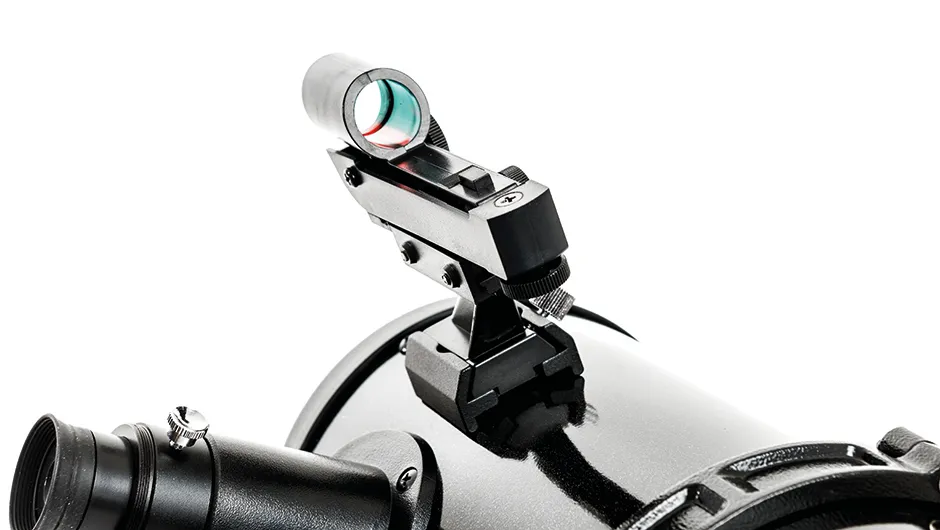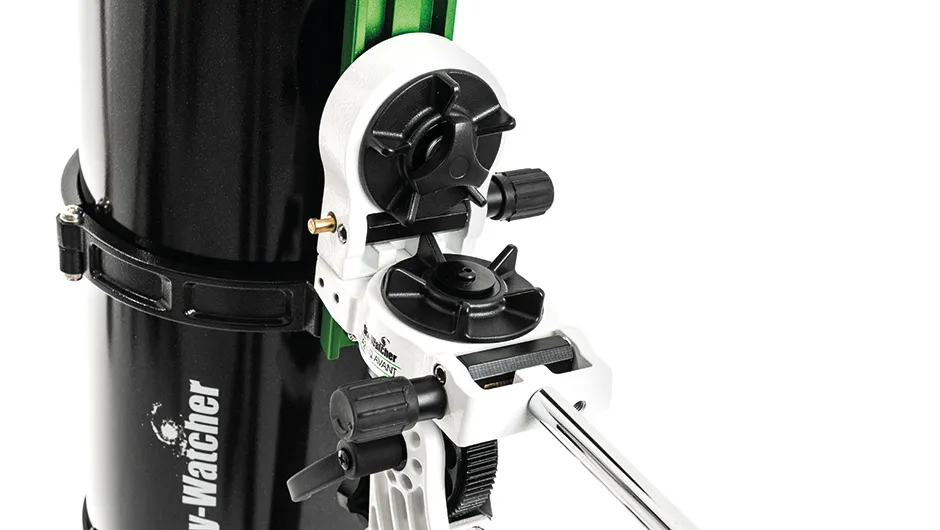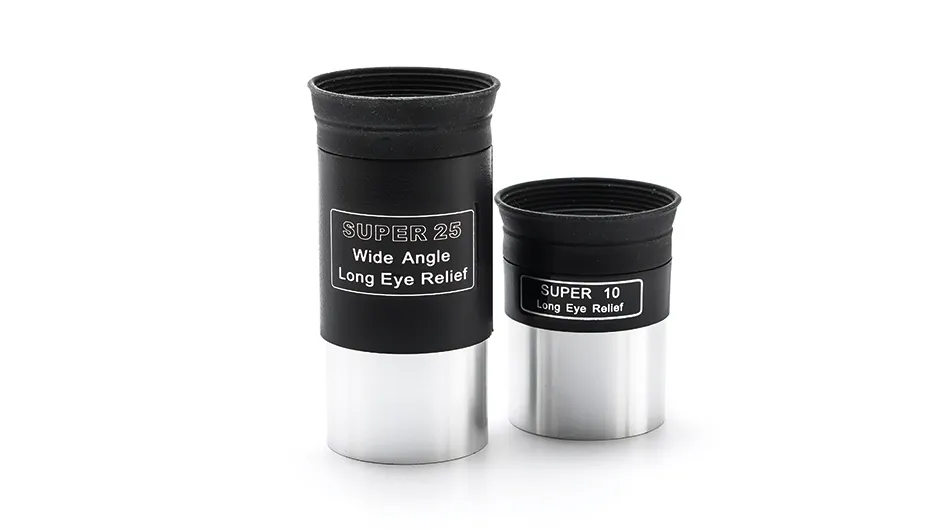The continuing problem of light pollution means a telescope that can be easily transported to dark-sky sites instantly has great appeal.And that’s exactly the sort of telescope Sky-Watcher’s new Explorer-130PS is intended to be.
The telescope and its AZ-EQ Avant mount are a compact and light package but the whole setup has also been designed with beginners in mind.
Assembly and operation are simple and user friendly in the hopes of providing a welcoming introduction to observing the night sky.
It uses a Newtonian reflector design that employs a parabolic primary mirror to collect and focus the light, and a flat secondary mirror to reflect it to the eyepiece.
This design requires collimation to align the two mirrors accurately with one another and the eyepiece.But, to make life easier for beginners, a large chunk of this potentially perplexing process has been removed.
This telescope features in our list of the best budget telescopes

The telescope has a fixed mirror cell for the primary mirror, which is collimated at the factory so it’ll only require occasional adjustment to the secondary mirror, for which a suitable Allen key is supplied.
Upon delivery, the review telescope was in excellent collimation and produced well-formed stars during this test – it really did work well straight out of the box.
The mount is just as important as the telescope and Sky-Watcher supplied the new, dual-mode AZ-EQ Avant mount with the Explorer-130PS so we were keen to see how it performed.
It didn’t disappoint, proving quick to assemble and providing a sturdy platform for the telescope.
An accessory tray for your eyepieces also serves as a tripod-leg tensioner to help stabilise the setup.
Adjustments in both altazimuth (AZ) and equatorial (EQ) modes are smooth and it’s easy to keep objects centred in the field of view.
In EQ mode, the altitude adjustment and locking clamp are simple to use although, with no method of installing a polarscope, polar alignment consists of sighting Polaris, the ‘North Star’, down the side of the optical tube with the counterbalance bar pointing downwards and towards the north.
But this is more than adequate for general observing purposes.

The Explorer-130PS also comes with a pier extension to keep the telescope from clipping the tripod legs while slewing and this got a lot of use throughout the review period.
The 130mm-aperture, steel optical tube is finished in a high-gloss black with a silver-flecked finish and is cradled in two substantial felt-lined tube rings, which are attached to a Vixen-style dovetail bar.
Surprisingly, the dovetail bar feature isn’t used to attach the telescope to the mount.
Instead, a 1/4in-20 bolt on the mount is screwed into a matching threaded hole in the base of the bar.
In use, this proved to be more than adequate for the purpose and no slippage was experienced during our tests.
A rather basic, plastic, single-speed rack-and-pinion focuser completes the optical tube but despite some initial reservations we found this to be effective in use.
With it we were able to achieve focus quickly and easily.

The supplied red dot finder is an excellent choice, especially for beginners, as it’s so easy and intuitive to use.We relied on it extensively for star hopping to various deep-sky objects.
The telescope’s 650mm focal length is a good compromise for observing a wide range of objects, including both Solar System and deep-sky targets.
We enjoyed some excellent views of M27, the Dumbbell Nebula, and M15 in Pegasus very early in the evening, then the Pleiades and the Hyades star clusters and M42 later during the night.
In both the 25mm and 10mm eyepieces the waxing gibbous Moon after Christmas was a wonderful sight through this telescope and would easily produce that wow factor for a beginner.
We really liked this scope and mount package.
It’s simple to assemble, easy to use and gives good views of some of the most popular targets.
The mount is very well thought out, light yet sturdy and the complete setup is very appealing.

Sky-Watcher Explorer-130PS telescope mount
Although at first glance the AZ-EQ Avant mount looks like a conventional altazimuth mount, it can actually be used in two modes.
In altazimuth (AZ) mode, the mount moves horizontally in a 360° circle (azimuth) and vertically (altitude) from the horizon to the zenith, the point in the sky immediately above the observer.
This makes it simple to locate astronomical targets.
But to follow these objects as they move across the night sky in an arc it’s necessary to make adjustments in both altitude and azimuth axes.
In equatorial (EQ) mode, the whole mount head is tilted on an adjustable wedge so that it points to the North Celestial Pole (in the northern hemisphere) or South Celestial Pole (in the southern hemisphere), around which the sky appears to rotate.
This means that once you’ve aligned the telescope on an object using the ‘horizontal’ adjustment (right ascension – RA) and the ‘vertical’ adjustment (declination – Dec.), it’s only necessary to make adjustments in the RA plane to follow the object as it traverses the sky.

Sky-Watcher Explorer-130PS telescope: 5 best features
Counterbalance bar and weight
Equatorial mounts require the weight of the telescope to be counterbalanced.
But the dual-mode design of the Avant mount means that even in altazimuth mode, the telescope is offset from the centre of the mount.
So it’s advisable to use the counterbalance bar and weight in both altazimuth and equatorial modes
Red dot finder
The red dot finder is a simple and intuitive method of locating bright objects such as stars.
It projects a red dot on to a clear window, which you look through to line the dot up on a star.
Once the star is located in the eyepiece, nearby objects can be found from this start point.
Tripod
The aluminium tripod is lightweight but surprisingly stable and proved to be a good match for the telescope and mount.
A substantial 21.5cm pier extension tube is included and, with this in place, the height to the centre of the telescope could be adjusted between 104mm and 152mm.
Slow-motion controls
Clutches on both mount axes can be released for quick movements to locate objects.
To track an object’s movement across the night sky, the clutches are tightened and two control knobs are rotated to follow the object’s path.
Even with the clutches tightened, the scope’s movements remained smooth.
Eyepieces
The Explorer-130PS is supplied with 25mm and 10mm eyepieces providing magnifications of 26x and 65x respectively.
These are ideal for a beginner, with the 25mm being the better of the two.
The 25mm has generous eye relief, making it suitable for spectacle wearers. Both have fold-up rubber eyecups.
Vital stats
- Price: £249.00
- Aperture: 130mm (5-inch)
- Eyepieces: 10mm, 25mm
- Weight: 9kg
- Supplier: Optical Vision Ltd
- Telephone: 01359 244200
- Website:www.opticalvision.co.uk
This review originally appeared in the March 2018 issue of BBC Sky at Night Magazine
